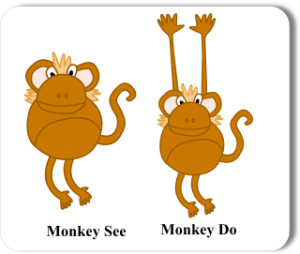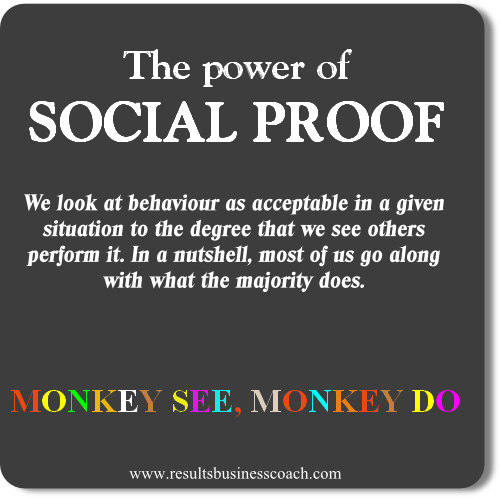 Most of us tend to accept what ‘the many’ accept.
Most of us tend to accept what ‘the many’ accept.
Most of us tend to reject what ‘the many’ reject.
Most of us tend to like what ‘the many’ like.
We look at behaviour as acceptable in a given situation to the degree that we see others perform it. In a nutshell, most of us go along with what the majority does.
Why?
As a rule, we tend to make fewer mistakes when we act according to social evidence than contrary to it. You arrive in a new town very late and you are looking for a ‘take away’ dinner before you check-in to your hotel. There are two fish and chip shops within a short distance. If one had a large queue and the other was empty, the chances are that you would have preferred the shop with a large queue. The reason? It is easy to assume that there must be something wrong with the empty fish&chip shop and that is why the majority are queuing at the other shop. You go along with what the majority does.
Power of ‘social proof’ is amplified, when the proof is provided by the conduct of several others.
Here is ‘social proof’ at work:
- Bartenders will often put their own money in the ‘Tips Jar’ at the beginning of the evening to give the impression that tipping is the norm.
- Church fundraisers will rattle their collection box with coins in them to get us to willingly donate.
- During the popular disco era, some discotheques created a long line outside (when there was plenty of room inside) to promote the impression that it was a popular club.
- Canned laughter in TV programmes. The canned laugh helps us decide what is funny and we go along with others.
- Nursery school children (67%) who were terrified of dogs were petting and playing with dogs, simply by watching a little boy play with dogs for 20 minutes each day. More importantly, this new behaviour continued to strengthen when looked a month later.
- The next evidence is amazing and shocking. I never expected human being to go to this extent to go along with the majority. The regions where suicides were highly publicized, fatal crashes were increased dramatically! The wider the publicity, higher the fatal crashes in that region. Professor David Phillips from University of California San Diego looked at suicide stats in US from 1947 to 1968. This is what he found. Within 2 months of every front-page suicide story, an average of 58 more people killed themselves. That is, every suicide story killed 58 more people, who would have otherwise not killed themselves. Professor Phillips links this powerful evidence of social proof to something called Werther effect.
When does ‘social proof’ work better?
Like any other behaviour ‘social proof’ works better under two conditions.
- Uncertainty: When we are uncertain, we tend to use other people’s behaviour as a guide to what we should do next. Social proof works best when the proof is provided by the actions of many other people. As John Kenneth Galbraith puts it, “The conventional view serves to protect us from the painful job of thinking.”
- Similarity: We are more likely to abide by social proof, when we are observing the behaviour of people just like us. This is the reason why we see ordinary people starring in most TV advertisements if the product is aimed at the masses.
How can business use ‘social proof?’
- Testimonials: An ideal customer sharing his or her positive experience on record has powerful persuasive influence.
- Case Studies: Usually in depth analysis of before and after (using a product or service) situation. Although this is written up by the business, the case study can go in to details as to what difference the product or service made to the customer’s life
- Customer Reviews: This is where customers give ‘star’ ratings
- Social shares: A modern form of ‘social proof’ – Facebook ‘Likes’, ‘Share’, Google Plus, social book marking etc… are considered a vote by public.
- Advertisements: Here I am referring to infomercials type ads, where a typical customer shares their experience of using the product.
- Approval from an expert: An expert is assumed to know the subject or issue in detail. Hence this saves time and ‘brain energy’ doing in depth work, most of us tend to go along with an expert.
When your prospect is in unfamiliar territory and feels unsure as to what to do next, they will look outside of themselves for evidence of how best to behave. Make it easy for your prospect to access that evidence.
Bibliography:Cialdini, Robert B. “Social Proof.” Influence: The Psychology of Persuasion. New York: Collins, 2007. N. pag. Print
+ Ravi Peal-Shankar



{ 0 comments… add one now }